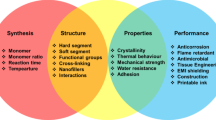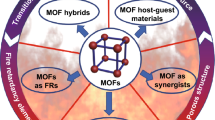Abstract
A flame-retardant tris(phenoxy)trifluorocyclotriphosphazenes, 2,4,6-N3P3(OPh)3F3 (TCTP) containing phenoxyl, fluorine, and cyclotriphosphazene ring was synthesized from hexachlorocyclotriphosphazene and added to polycarbonate (PC) to improve flame retardancy. Its chemical structure was confirmed by Fourier transform infrared (FTIR) and nuclear magnetic resonance. The synthesis of TCTP was designed to improve the flame retardancy of PC without harming PC excellent optical and mechanical performances. The flame retardancy and thermal degradation behavior of PC/TCTP composites were investigated with the limiting oxygen index (LOI), UL-94 vertical burning test, microscale combustion calorimeter, thermogravimetric analysis, and differential scanning calorimetry. Scanning electron microscopy (SEM) analyses and FTIR spectrophotometer were brought together to study the structure of residual char. The optical and mechanical properties of PC were also taken into consideration at the same time. When 10 % TCTP was incorporated, the LOI of composite achieved the maximum of 40 %, and class V-0 of UL-94 test was passed. The phenomena of SEM and FTIR stated that there was interaction between PC and TCTP to form new stable film in mid of residual char. Light transmittance, tensile, and flexural strength of PC/TCTP systems were improved at different levels.










Similar content being viewed by others
References
Levchik SV, Weil ED. Flame retardants in commercial use or in advanced development in polycarbonates and polycarbonate blends. J Fire Sci. 2006;24(2):137–51.
Olabisi O, Kolapo A (editors). Handbook of thermoplastics [M]. Chemical rubber company press; 1997. Vol. 41.
Levchik SV, Weil ED. Overview of recent developments in the flame retardancy of polycarbonates. Polym Int. 2005;54(7):981–98.
Feng J, Hao J, Du J, Yang R. Flame retardancy and thermal properties of solid bisphenol A bis (diphenyl phosphate) combined with montmorillonite in polycarbonate. Polym Degrad Stab. 2010;95(10):2041–8.
Liu S, Ye H, Zhou Y, et al. Study on flame-retardant mechanism of polycarbonate containing sulfonate-silsesquioxane-fluoro retardants by TG and FTIR. Polym Degrad Stab. 2006;91(8):1808–14.
Wang YZ, Yi B, Wu B, et al. Thermal behaviors of flame-retardant polycarbonates containing diphenylsulfonate and poly (sulfonylphenylene phosphonate). J Appl Polym Sci. 2003;89(4):882–9.
Singler RE, Hagnauer GL, Schneider NS, et al. Synthesis and characterization of polyaryloxyphosphazenes. J Polym Sci. 1974;12(2):433–44.
Wisian-Neilson P, Allcock HR, Wynne KJ. Inorganic and organometallic polymers II: advanced materials and intermediates: developed from a symposium sponsored by the Division of Polymer Chemistry, Inc., at the 205th National Meeting of the American Chemical Society, Denver, Colorado, March 28–April 2, 1993. ACS, 1994.
Kumar D, Fohlen GM, Parker JA. The curing of epoxy resins with aminophenoxycyclotriphosphazenes. J Polym Sci Part A. 1986;24(10):2415–24.
Kumar D, Khullar M, Gupta AD. Synthesis and characterization of novel cyclotriphosphazene-containing poly (ether imide)s. Polymer. 1993;34(14):3025–9.
Zhang T, Cai Q, Wu DZ, et al. Phosphazene cyclomatrix network polymers: some aspects of the synthesis, characterization, and flame-retardant mechanisms of polymer. J Appl Polym Sci. 2005;95(4):880–9.
Çoşut B, Hacıvelioğlu F, Durmuş M, et al. The synthesis, thermal and photophysical properties of phenoxycyclotriphosphazenyl-substituted cyclic and polymeric phosphazenes. Polyhedron. 2009;28(12):2510–6.
Weil ED. Encyclopedia of polymer science and technology, vol. 11. New York: Wiley Interscience; 1986.
Aronson AM. Phosphorous Chemistry[C]//ACS Symposium. 1992, 486: 218.
Kourtides DA. Thermochemical and flammability properties of some thermoplastic and thermoset polymersa review. Polym Plast Technol Eng. 1978;11(2):159–98.
Calleman CJ, Bergmark E, Costa LG. Acrylamide is metabolized to glycidamide in the rat: evidence from hemoglobin adduct formation. Chem Res Toxicol. 1990;3(5):406–12.
Levchik SV, Camino G, Costa L, et al. Mechanism of action of phosphorus -based flame retardants in nylon 6. I. Ammonium polyphosphate. Fire Mater. 1995;19(1):1–10.
Potin P, De Jaeger R. Polyphosphazenes: synthesis, structures, properties, applications. Eur Polym J. 1991;27(4):341–8.
Levchik SV. Introduction to flame retardancy and polymer flammability. NJ: Wiley; 2007.
Kumar D, Fohlen GM, Parker JA. Fire-and heat-resistant laminating resins based on maleimido-substituted aromatic cyclotriphosphazenes. Macromolecules. 1983;16(8):1250–7.
Kannan P, Kishore K. Polyethylene stibinite phosphate esters: novel flame-retardant plasticizers for PVC. Eur Polym J. 1997;33(10):1799–803.
Annakutty KS, Kishore K. Flame retardant polyphosphate esters: 1. condensation polymers of bisphenols with aryl phosphorodichloridates: synthesis, characterization and thermal studies [J]. Polymer. 1988;29(4):756–61.
Kannan P, Kishore K. Novel flame retardant polyphosphoramide esters. Polymer. 1992;33(2):418–22.
Pawlowski KH, Schartel B. Flame retardancy mechanisms of aryl phosphates in combination with boehmite in bisphenol A polycarbonate/acrylonitrileebutadienee styrene blends. Polym Degrad Stab. 2008;93(3):657–67.
Allen CW, Tsang FY, Moeller T. Aryl-substituted phosphonitrilic fluorides. III. Geminally substituted phenylphosphonitrilic fluoride trimers. Inorg Chem. 1968;7(11):2183–8.
Babushok VI, Tsang W. Kinetic modeling of heptane combustion and PAH formation. J Propuls Power. 2004;20(3):403–14.
Li L, Li X, Yang R. Mechanical, thermal properties, and flame retardancy of PC/ultrafine octaphenyl-POSS composites. J Appl Polym Sci. 2012;124(5):3807–14.
Wang Jiangbo, Xin Zhong. Flame retardancy, thermal, rheological, and mechanical properties of polycarbonate/polysilsesquioxane system. J Appl Polym Sci. 2010;115(1):330–7.
Lyon RE, Walters RN. Pyrolysis combustion flow calorimetry. J Anal Appl Pyrolysis. 2004;71(1):27–46.
Lyon RE, Walters R. A microscale combustion calorimeter. Federal aviation administration Washington DC office of aviation research, 2002.
Lyon RE, Walters RN, Stoliarov SI. A thermal analysis method for measuring polymer flammability. J ASTM Int. 2006;3(4):1–18.
Lyon RE, Walters RN. Microscale combustion calorimeter, US Patent5, 981, 290, November 9 (1999).
ASTM D 7309-13, Standard test method for determining flammability characteristics of plastics and other solid materials using microscale combustion calorimetry. American Society for Testing and Materials, Developed by Subcommittee: D20.30.
Schartel B, Pawlowski KH, Lyon RE. Pyrolysis combustion flow calorimeter: a tool to assess flame retarded PC/ABS materials? Thermochim Acta. 2007;462(1):1–14.
Tang Z, Li Y, Zhang YJ, et al. Oligomeric siloxane containing triphenyl phosphonium phosphate as a novel flame retardant for polycarbonate. Polym Degrad Stab. 2012;97(4):638–44.
Acknowledgements
We would like to thank the generous supports by the following: Dr. Tiannan Zhou; the Experiment Center of Polymer Science and Engineering Academy, Sichuan University; Xinhui Science and Technology co., Ltd; National Natural Science Foundation of China, Grant No. 50973066.
Author information
Authors and Affiliations
Corresponding author
Rights and permissions
About this article
Cite this article
Yang, Y., Kong, W., Wang, Y. et al. Synthesis of tris(phenoxy)trifluorocyclotriphosphazenes and study of its effects on the flammable, thermal, optical, and mechanical properties of bisphenol-A polycarbonate. J Therm Anal Calorim 122, 805–816 (2015). https://doi.org/10.1007/s10973-015-4737-3
Received:
Accepted:
Published:
Issue Date:
DOI: https://doi.org/10.1007/s10973-015-4737-3




